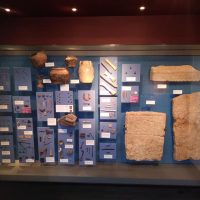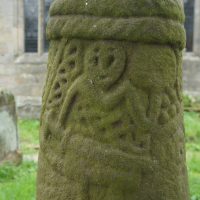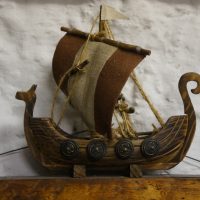In this area we present our blog posts on a variety of Viking subjects from a variety of authors. Please scroll down or use the filter to look at specific subjects…
Explore our blog posts...

The Vikings in Lincoln
by Dr Erik Grigg, Learning Officer, The Collection, Lincoln The Collection in Lincoln has a fascinating Viking display, some of which were found nearby as it is located in the heart of an important Viking trading settlement. Even the local street names indicate Scandinavian origin and demonstrate the enduring influence of the Scandinavian settlers on the area: on one side of the museum is Danesgate which means 'Danish Street' (gata being the Old Norse for street). The use of Old Norse gata persists in other street names around The Collection: Flaxengate, meaning the street where people were turning flax into linen to make clothes, lies immediately to the west, while Michaelgate and Hungate are only a short walk away. ‘Gate’ has become the local word for ‘street’ thanks to the Scandinavian settlers in the Viking Age. The Vikings first turned up in the area in the 870s and the Great Heathen Army made camp at nearby Torksey. The museum has a small case of finds from the recent excavations there including pieces of gold and silver hacked into convenient bits to use as treasure or currency. After they established control, the Vikings soon settled down and turned the old Roman city of Lincoln into a vibrant trading borough. Coins and a coin die used to make them are on display in the museum as Lincoln was an important mint. The Vikings kept themselves clean and tidy and the museum has the reconstruction of a Viking comb-maker's workshop. The finest piece on display is an eleventh or twelfth century Urnes mount, a sumptuous piece of Viking metalwork with the typical motif of intertwined dragons. Carved grave covers, a sword, axe heads and bone ice skates are also found in The Collection as well as a recently discovered rare gold Thor's Hammer pendant. Dr Grigg has written more about the Viking Borough of Lincoln on the Visit Lincoln website.
Read More

Some Derbyshire Warriors
Of the East Midlands counties, Derbyshire is perhaps the least well known for its Viking Age remains, apart of course from the camp at Repton. There is a scatter of place-names that suggest that members of that camp settled down in the region. And the recent publication of the Derbyshire volume of the Corpus of Anglo-Saxon Stone Sculpture provides further clues. At Brailsford, not far from Derby, a moss-covered cross-shaft stands outside the church, depicting a figure with a small shield and a rather large sword. The Corpus volume describes this as a 'battle-ready warrior' (p. 91) and suggests (p. 157) that this unusual warrior image is a memorial stone or marker of a member of the Anglo-Scandinavian warrior elite. The stone is loosely dated to the tenth century, so it could represent someone who had been at Repton, or more likely one of his descendants. Another warrior figure can be found on a cross-shaft at Norbury, to the west of Brailsford. This figure has a sword and what looks like a horn. The Corpus volume suggests (p. 194) that this is similarly a memorial to a member of the warrior elite. But it also raises the intriguing possibility that the figure represents the Norse god Heimdallr, whose horn announces the beginning of Ragnarök. While a bit speculative, this is not impossible since Heimdallr is fairly certainly represented on the Gosforth cross in Cumbria and possibly on the Jurby cross in the Isle of Man. Though there seem to be only two warrior-figures from Derbyshire, there are plenty of other Anglo-Scandinavian sculptures. There are (or were) two hogbacks: one from Repton which is lost but known from drawings, and one from Derby which can be seen in the museum there. There are a number of crosses and cross-shafts with various types of Viking Age ornament. Particularly interesting is part of a cross-shaft from Bakewell with Borre-style ring-chain (p. 122). This type of ornament is associated with the Irish Sea region and demonstrates the links the East Midlands had with the rest of the Viking world. Who all these memorials represent is a fascinating question we would all love to know the answer to. Most intriguing of all is a rune-inscribed fragment, also from Bakewell. The runes are very clearly Anglo-Saxon, yet as interpreted by David Parsons (p. 142) they most likely represent the Scandinavian male personal name Helgi (or its female equivalent Helga).
Read More

Bringing Vikings Back to the East Midlands
As this website is about to go live, it seems right to reflect on what has happened over the last year and a half and where we are going next. 2017 and 2018 were very busy with our 'Bringing Vikings Back to the East Midlands'. It all started when the University Museum heard that it would be one of the venues for the British Museum travelling exhibition Viking: Rediscover the Legend. We began making some preparations for associated activities, and were lucky enough to get a substantial grant from the Arts and Humanities Research Council to support these activities. We were even luckier that Dr Roderick Dale, formerly of the World-Tree Project at University College, Cork, was available to take on the post of Cultural Engagement Officer and to manage these activities. We then started thinking bigger and planned, and got funding for, a second exhibition, Danelaw Saga, and a popular book on Viking Nottinghamshire. You can read about all of these things in more detail on our About the Project page. One important aspect of that project was to fix some of what was achieved then for the future, hence this site, which we think of as a virtual museum. Here, you will be able to catch up on some of the talks that you might have missed during the exhibitions. You will also be able to see many of the items featured in the Danelaw Saga exhibition, with more information about where to go to see them in museums, or on the Portable Antiquities scheme website. A strong feature of our exhibition-related activities were the handling sessions with museum-quality reproductions of Viking Age artefacts made especially for us by Adam Parsons of Blueaxe Reproductions - we now have high-quality photos of these for you to download and marvel at how the objects would have looked when they were new. A further exciting feature are the Viking designs made for us by Adam - these are line drawings which you can use for whatever educational or entrepreneurial purpose you might have. They are open-access and available to use under Creative Commons CC-BY-4.0. Other features of this museum, such as the place- and personal names and runes are still in development, so keep coming back to find something new. Although the original project is now officially over, Roderick is still with us for phase 2. He will keep working on this site during the coming year, alongside some other duties, so bear with us as we keep making it better and more detailed. Do explore this virtual museum and let us know what you think on our Twitter account @emidsvikings.
Read More

The East Midlands in the Viking Age
Vikings in the East Midlands is a brand-new virtual museum highlighting a number of aspects of the Viking heritage of the East Midlands. It is part of a larger project funded by the Arts and Humanities Research Council and the British Identities Research Priority Area of the University of Nottingham. The larger project (Bringing Vikings Back to the East Midlands) included two exhibitions and a variety of other activities. In our museum you will find a record of some of those activities, such as the talks given by leading Viking experts. The main aim of this virtual museum is to present some of the most important evidence for the Viking Age in the East Midlands, focusing in particular on artefacts and names. As well as original artefacts, we also present modern reproductions of those artefacts to give an idea of what they would have looked like when new. You will also find designs based on those artefacts which can be used for creative, educational and entrepreneurial purposes under a Creative Commons license. We also highlight the place-names of the region, which are some of the most important evidence for the Viking impact, and the Scandinavian personal names introduced by the Viking settlers. Finally, we introduce the Viking Age uses of the runic alphabet. Although we go live on the 1st August 2018, this virtual museum is by no means complete, but there should be more than enough here for you to browse and find items of interest. We will continue adding material throughout the coming year. If you would like to contact us, the best way is through our Twitter account @emidsvikings.
